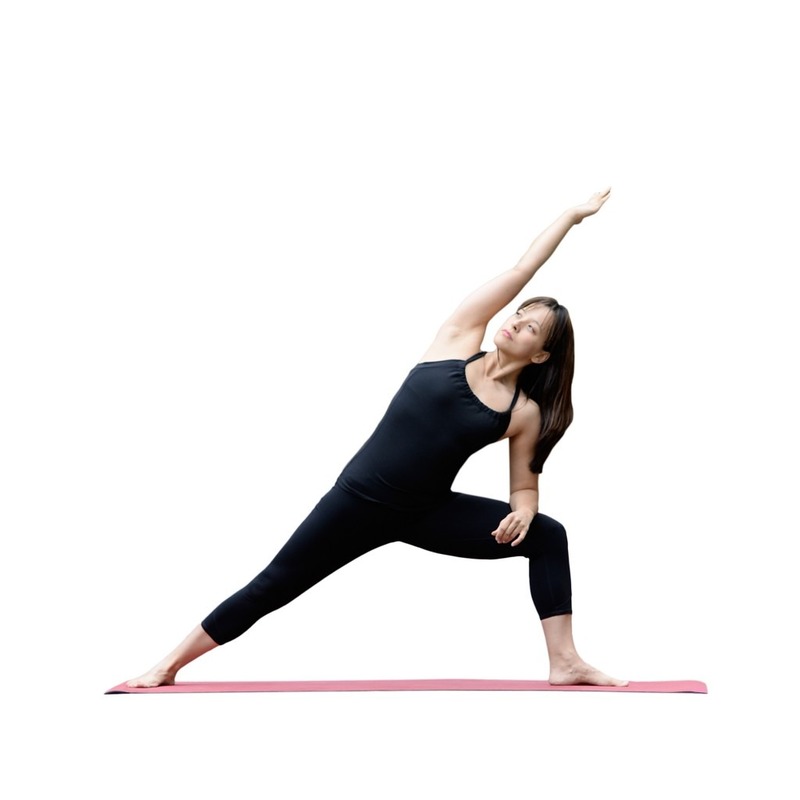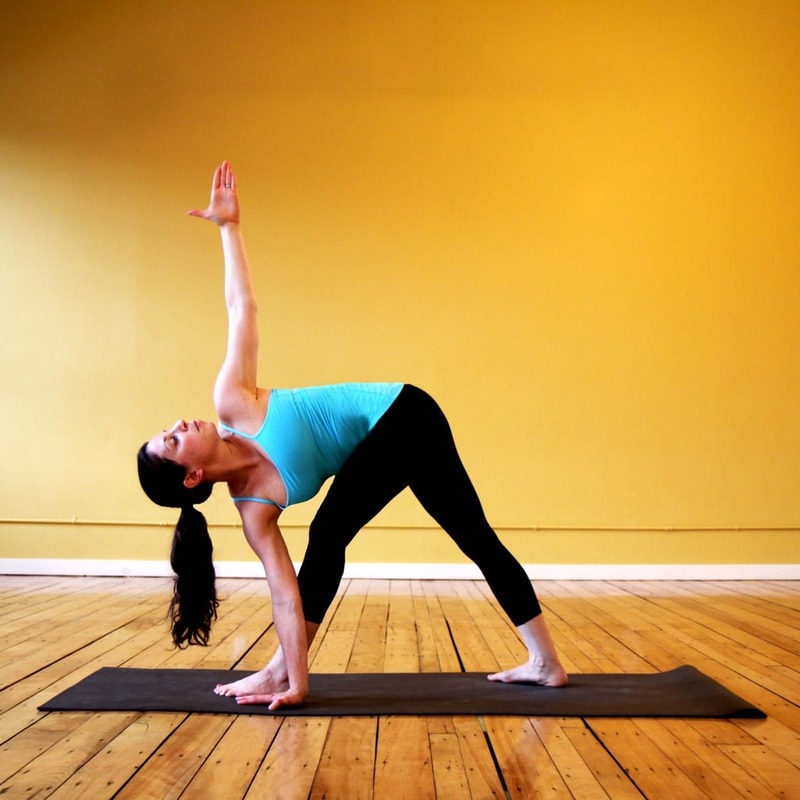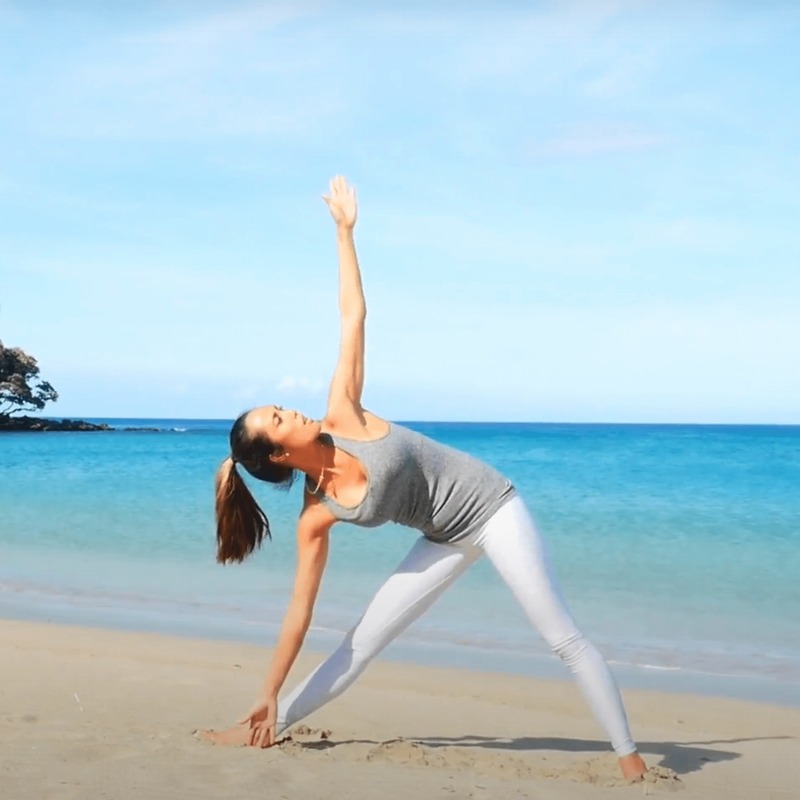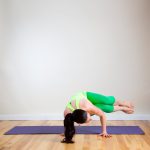The Fundamentals of Trikonasana (Triangle Pose)
Trikonasana, or the Yoga triangle pose, is a classic yoga pose. It is part of many yoga sequences. This pose challenges your balance and offers a deep stretch to the legs. Your hips, chest, and shoulders also benefit from it. To do the pose, you start in a standing position. Then, you spread your feet wide apart. Turn one foot outwards, and the other slightly in.
You extend your arms to the sides at shoulder height. You then bend sideways over the outward-turned leg. The idea is to keep your waist long and your spine straight. Reach down with one hand, preferably to your ankle or shin. Your other hand goes up, towards the sky. Your gaze can follow the upward hand, or look straight ahead. It’s important to keep both sides of your waist long. Avoid collapsing the waist or hunching the shoulders.
Good alignment means your body looks like a flat ‘T’ from the front. Your hips and shoulders should be in one line. Your chest should be open. Trikonasana stretches the legs and hips, strengthens the thighs, knees, and ankles. It also opens the chest and shoulders. It can improve digestion, and reduce stress. Remember to breathe smoothly and evenly.
Proper form in Trikonasana is more important than how deep you go. Don’t worry if your hand doesn’t reach the ground. It’s better to use a block or rest your hand higher up. This ensures your spine stays long and alignment stays true. Trikonasana asks for both stability and flexibility. It is a perfect balance of effort and ease.

Importance of Proper Alignment in Triangle Pose
Proper alignment in the yoga triangle pose is crucial. It ensures safety and maximizes benefits. This pose calls for precision and attention to each body part position. Good alignment protects joints and muscles from strain. It sets a foundation for more advanced practice. Trikonasana is powerful when done with correct form. Let’s break down the key alignment points.
- Start with feet wide and one foot turned out.
- Keep the spine long, like in Tadasana (Mountain Pose).
- Stretch the arms wide to maintain balance.
- Bend sideways over the turned-out leg, not forward.
- Avoid hunching shoulders or collapsing the waist.
- Reach down without compromising the spine’s length.
Misalignment can lead to poor muscle engagement. It can also cause unnecessary pressure on joints. Proper form allows for a better stretch in the legs and torso. It enables strengthening the right muscles. Always aim to keep your hips and shoulders in one line.
Remember to use props if reaching down is hard. A yoga block or chair can help. They keep the spine straight and support good posture. Never push the body into uncomfortable positions. Work within your range and focus on keeping the chest open. This way, you take care of your body while doing Trikonasana. Alignment takes practice, so be patient and consistent.
The Impact of Incorrect Hand Placement
In the yoga triangle pose, hand placement is key. When done wrong, it can harm more than help. Let’s consider the effects of incorrect hand placement.
Placing the hand too low can cause issues:
- Rounded Spine: Going for the floor can round the back. This goes against the pose’s goal to keep the spine long.
- Misaligned Hips: To reach down, hips may shift wrongly. This makes the alignment off balance.
- Shortened Side Body: Rushing to touch the ground can shorten the side. This lessens the stretch and weakens the pose.
- Bent Knee: Reaching too far often bends the front knee. This takes away from the leg stretch the pose aims for.
- Strained Shoulders: Hunching to reach strains shoulders. This closes the chest instead of opening it.
Putting the hand on a higher point saves alignment:
- Straight Spine: A block or chair can help maintain a long spine.
- Aligned Hips: When not overreaching, hips stay more aligned.
- Even Side Stretch: Both sides of the torso remain long. This makes the stretch even throughout.
- Straight Leg: The temptation to bend the knee lessens. This keeps the stretch strong in the front leg.
- Relaxed Shoulders: Lesser reach equals less strain. Shoulders stay open, aiding in a large chest expansion.
In Trikonasana, aiming for a proper hand position ensures a balanced form. Use props as aids, not as an end goal. The essence of the pose lies in the journey to proper alignment, not just the destination.
Benefits of Using Props for Triangle Pose
Using props in Trikonasana, or the yoga triangle pose, offers several advantages. Props like blocks or chairs can help maintain proper alignment. They prevent overstretching and reduce the risk of injury. Here are some key benefits of using props in triangle pose:
- Reduce Strain: Props reduce strain on muscles and joints. They make the pose accessible for all levels.
- Enhance Stability: With support, you can focus on balance and stability. It’s easier to hold the pose longer.
- Improve Alignment: Props help align hips, shoulders, and spine. This better distributes effort throughout the body.
- Increase Accessibility: Not everyone can touch the ground. Props bridge the gap, making the pose achievable.
- Encourage Relaxation: When you feel supported, it’s easier to relax. This can deepen your stretch and increase flexibility.
In conclusion, props are not a sign of weakness.Remember, the goal is to maintain a long spine and open chest. Props help you achieve just that.

Trikonasana with a Tadasana (Mountain Pose) Spine
Maintaining a Tadasana spine in Trikonasana, or the yoga triangle pose, is vital. It ensures the spine remains long and strong during practice. Here’s how to merge these two key poses:
- Start in a Tadasana stance. Feel the length of your spine and the balance in your feet.
- Transition slowly. Keep the hips and shoulders aligned as you widen your stance.
- Rotate your foot outwards. The back foot angles slightly in, but keep your spine straight.
- As you lean over the outward-turned leg, hinge from your hips. This maintains the Tadasana spine.
- Avoid bending the spine or collapsing the waist. Imagine the strength of a mountain in your posture.
In Tadasana, your body stands tall and firm. Think of this when you enter Trikonasana. Your chest should be broad, hips square, and your spine a column of support. Any bend comes from the hips, not the back.
When done right, Trikonasana with a Tadasana spine strengthens your core. It also promotes better breathing and focus. It can correct posture over time. Always remember, it’s about holding a pose correctly, not how deep you go. Keep your movements mindful and intent on alignment. This will keep your yoga triangle pose safe and effective.
Step-by-Step Guide to Achieving the Optimal Triangle Pose
Achieving Trikonasana, or the yoga triangle pose, involves precise steps. Let’s go through them for the best outcomes:
- Start Standing: Begin in Tadasana (Mountain Pose). Feel your feet solid on the ground.
- Spread Feet: Step your feet about a leg’s length apart. Keep your spine straight.
- Foot Placement: Turn your right foot out 90 degrees. Your left foot in slightly.
- Raise Arms: Lift your arms to shoulder height. Keep them parallel to the floor.
- Side Bend: Hinge at the hip and bend over your right leg. Maintain a flat back.
- Hand Position: Reach your right hand down. Place it on a block, leg, or floor. Reach left hand up.
- Gaze: Look up at your left hand. If this strains your neck, look forward or down.
- Hold and Breathe: Stay in the pose for several breaths. Keep your chest open.
- Switch Sides: Come up to standing. Repeat the same steps on the opposite side.
Following these steps can help ensure proper form and alignment. Remember to listen to your body. Use props if needed. Be patient with your progress in the yoga triangle pose.

Adjusting Triangle Pose for Different Body Types
The yoga triangle pose, or Trikonasana, is not one-size-fits-all. Different body types require adjustments for a safe and effective practice. Here’s how to make Trikonasana accessible for various bodies:
- Analyze Body Proportions: Check the ratio of torso to leg length. Those with a long torso may need a higher hand placement, such as on a block.
- Be Mindful of Flexibility: Remember, flexiblity varies. Encourage students to find a stretch that feels right without forcing their bodies.
- Prioritize Comfort: Comfort is key. Suggest placing the hand on the shin rather than forcing it to the floor or block for someone who feels strained.
- Acknowledge Strength Levels: Not everyone has the same strength. Props can aid those needing extra support in maintaining a long spine and open chest.
- Honor Joint Health: Pay attention to students with joint issues. They may need to adjust their stance width or hand placement to avoid pain.
- Use Props Wisely: Props like blocks or cushions can raise the floor to meet the hand. This prevents overreaching and supports better alignment.
- Tailor to the Individual: Each person’s Trikonasana may look different. Customize the pose based on personal range of motion and comfort.
Remember, the goal of yoga is to harmonize the body and mind, not to mirror a textbook pose. By making these adjustments, each individual can experience the true essence of the yoga triangle pose.
The Role of Trikonasana in Sequencing and Transitioning
When it comes to yoga sequences, Trikonasana, or the yoga triangle pose, plays a crucial role. This pose serves as a bridge between standing and bending asanas. It prepares the body for deeper stretches and transitions. Its placement in a sequence is often strategic, aiding in the flow of movements.
In a typical sequence, Trikonasana often follows foundational poses like Tadasana. It leads into more complex asanas — think arm balances or inversions. Its ability to open the hips and shoulders makes it the perfect precursor. For example, after Trikonasana, you might move into Ardha Chandrasana (Half Moon Pose). This progression takes advantage of the body’s newfound openness.
During transitioning, Trikonasana encourages stability and focus. It sharpens concentration, which is essential for the smooth execution of subsequent poses. Balance is a critical factor in many yoga poses. This asana helps build that balance, especially in the legs and core.
Trikonasana also has a cooling effect on the body. After an intense series of poses, it serves as a gentle interlude. It can provide a moment of recovery before moving onto more demanding asanas.
Lastly, Trikonasana has a symmetrical nature. It ensures that both sides of the body receive equal attention. This symmetry brings balance to the body and mind. It’s important to practice on both sides for equitable strength and flexibility.
In any yoga practice, integrating Trikonasana thoughtfully can enhance the experience. Its role in sequencing and transitioning underlines the importance of flow and balance. It’s a testament to its versatility and central role in yoga development.


